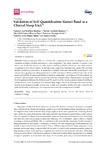Validation of Self-Quantification Xiaomi Band in a Clinical Sleep Unit

Use this link to cite
http://hdl.handle.net/2183/26457Collections
- Investigación (FCS) [1293]
Metadata
Show full item recordTitle
Validation of Self-Quantification Xiaomi Band in a Clinical Sleep UnitAuthor(s)
Date
2020-08-21Citation
Martínez-Martínez FJ, Concheiro-Moscoso P, Miranda-Duro MC, Docampo Boedo F, Mejuto Muiño FJ, Groba B. Validation of Self-Quantification Xiaomi Band in a Clinical Sleep Unit. Proceedings. 2020; 54(1):29
Abstract
[Abstract]
Polysomnography (PSG) is currently the accepted gold standard for sleep studies, as it
measures multiple variables that lead to a clear diagnosis of any sleep disorder. However, it has
some clear drawbacks, since it can only be performed by qualified technicians, has a high cost and
complexity and is very invasive. In the last years, actigraphy has been used along PSG for sleep
studies. In this study, we intend to assess the capability of the new Xiaomi Mi Smart Band 5 to be
used as an actigraphy tool. Sleep measures from PSG and Xiaomi Mi Smart Band 5 recorded in the
same night will be obtained and further analysed to assess their concordance. For this analysis, we
perform a paired sample t-test to compare the different measures, Bland–Altman plots to evaluate the
level of agreement between the Mi Band and PSG and Epoch by Epoch analysis to study the ability of
the Mi Band to correctly identify PSG-defined sleep stages. This study belongs to the research field
known as participatory health, which aims to offer an innovative healthcare model driven by the
patients themselves, leading to civic empowerment and self-management of health.
Keywords
Sleep
Polysomnography
Participatory health
Xiaomi Mi Smart Band 5
Internet of things
Polysomnography
Participatory health
Xiaomi Mi Smart Band 5
Internet of things
Editor version
Rights
Atribución 4.0 España
ISSN
2504-3900






